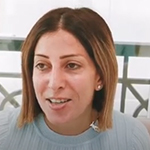Dermal fillers are non-surgical injectables designed to restore volume, smooth lines, and enhance facial contours using substances like hyaluronic acid (HA). A key feature of HA fillers is cross-linking, a process that stabilizes the HA molecules to create a gel-like structure that can retain volume and last longer within the skin. This cross-linking process affects the filler’s thickness, longevity, and suitability for different treatment areas—ranging from fine lines to deep volume restoration.
There are also other types of fillers, such as those with collagen-stimulating properties, that gradually improve the skin’s texture and elasticity.
Dermal fillers can be categorized based on their volumizing or biostimulatory effects:
Volumizing Fillers: Provide an instant plumping effect, primarily using HA-based products. They focus on immediate enhancement of facial volume and structure. Most volumizing fillers are made of hyaluronic acid (HA).
- Add volume to the cheeks, lips, and jawline.
- Smooth out deep wrinkles, like nasolabial folds.
- Contour the chin or reshape facial structure.
- Restore volume in aging hands.
Biostimulatory Fillers: Gradually improve skin by stimulating collagen production. Their effects appear over time, and they offer more prolonged changes in skin quality and firmness.
- Smoothing fine lines and improving skin laxity.
- Enhancing skin texture and quality over time.
- Providing subtle volume while encouraging collagen growth.
Choosing between volumizing or biostimulatory fillers depends on the patient’s goals, such as achieving instant volume or promoting long-term skin rejuvenation and structural enhancement.
Available HA Fillers at Ivory Aesthetics Clinic:
Juvederm Volite: A cross-linked hyaluronic acid injectable designed to boost skin hydration, smooth fine lines, and enhance elasticity, with results lasting up to nine months.
Juvederm Volift: A cross-linked hyaluronic acid filler designed for smoothing moderate to deep wrinkles and restoring facial contours with natural, long-lasting results.
Restylane Volyme: A cross-linked HA filler designed to restore deep facial volume and enhance contours in areas like the cheeks and jawline.
Restylane Lyft: A robust cross-linked filler used for enhancing volume in the cheeks, hands, and correcting deeper wrinkles and folds.
Restylane Defyne: Specifically formulated to smooth deeper laugh lines and maintain natural facial expressions with a flexible, cross-linked gel.
Restylane Kysse: Created for lip enhancement, this cross-linked filler delivers natural-looking volume, softness, and improved lip texture and color.
Restylane Vital Light: A non-cross-linked HA skin booster that improves skin hydration, elasticity, and smoothness, targeting fine lines and dullness.
Aliaxin LV (Lips Volume): Cross-linked HA filler for enhancing lip volume, shape, and contour with a natural look.
Aliaxin SV (Superior Volume): Cross-linked filler that restores volume and enhances contours, ideal for cheeks and jawline.
Aliaxin EV (Essential Volume): Cross-linked HA designed to correct deep lines and restore facial volume with a lifting effect.
Teosyal PureSense Redensity I: A non-cross-linked HA used for skin hydration, rejuvenation, and fine lines, providing a more natural, refreshed appearance.
Available Biostimulatory Injectables at Ivory Aesthetics Clinic:
Radiesse: A CaHA microsphere in a gel carrier providing immediate volume when injected as a bolus and collagen-stimulating effects when diluted for biostimulatory treatments.
Sculptra: A poly-L-lactic acid (PLLA) injectable that gradually restores volume through collagen stimulation, offering long-lasting, biostimulatory effects for natural skin rejuvenation.
Benefits of Dermal Fillers
- Immediate Results: Most dermal fillers show results immediately after the treatment.
- Non-Surgical Solution: Minimally invasive, with little to no downtime.
- Customizable: Treatments can be tailored to address specific aesthetic goals.
- Natural-Looking Effects: Enhances your features while maintaining a natural appearance.
- Boosts Collagen Production: Some fillers stimulate natural collagen for long-lasting improvement.
- Restores Volume: Rejuvenates areas that have lost fullness over time.
Treatment Areas for Dermal Fillers
Dermal fillers can be used in a variety of areas to improve aesthetics and rejuvenate your look, such as:
- Lips: For adding fullness and shape.
- Cheeks: To restore lost volume and create a youthful contour.
- Nasolabial Folds (Smile Lines): To soften deep creases.
- Marionette Lines: To reduce the appearance of sagging or folds around the mouth.
- Jawline & Chin: To define and enhance facial structure.
- Under Eyes (Tear Troughs): For minimizing hollows and dark circles.
- Nose: Reshape and contour the nose, correct bumps, and enhance symmetry.
- Hands: To restore lost volume and smooth texture.
- Neck Biostimulation: Injectables that stimulate collagen production to improve skin texture, tighten, and reduce sagging on the neck.
Who Is This Treatment For?
Dermal fillers are suitable for individuals looking to:
- Enhance facial features such as lips and cheeks.
- Reduce the appearance of wrinkles, folds, or volume loss.
- Improve overall facial symmetry and contours.
- Achieve a rejuvenated, youthful look without surgery.
Note: A consultation with a doctor is necessary to determine if dermal fillers are right for you and to discuss personalized treatment plans.
FAQs
How long do dermal fillers last?
The longevity of dermal fillers depends on the type used and the area treated, generally lasting from 6 months to 2 years.
Is there any downtime after dermal filler treatment?
Minimal downtime is required, though some patients may experience mild swelling, bruising, or redness at the injection site.
Are dermal fillers safe?
Yes, when administered by a trained professional. Side effects are rare and typically temporary.
When will I see results?
Many people notice results immediately, with full effects becoming more evident once any initial swelling subsides.
Can dermal fillers be dissolved?
Hyaluronic acid-based fillers can be dissolved using an enzyme called hyaluronidase if necessary.
How long does the procedure take?
Most sessions take about 30 minutes, depending on the treatment areas.




